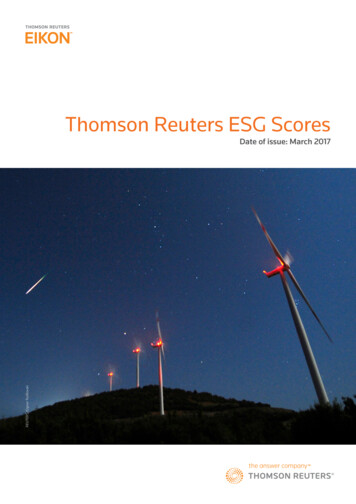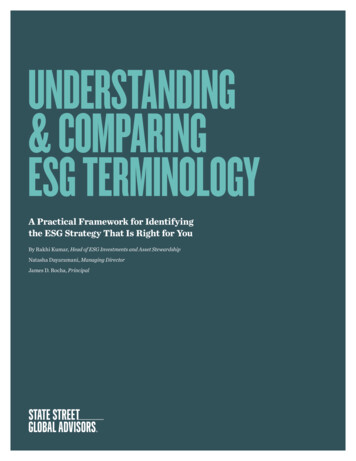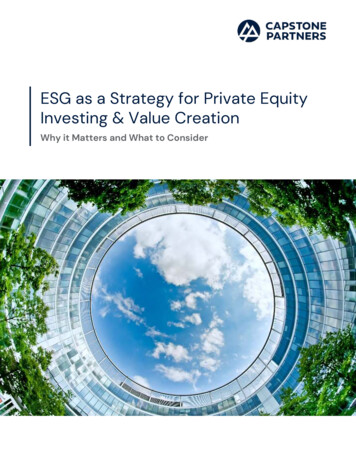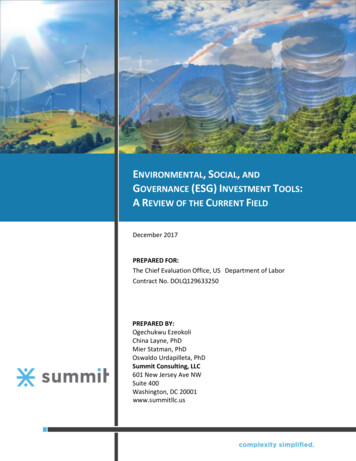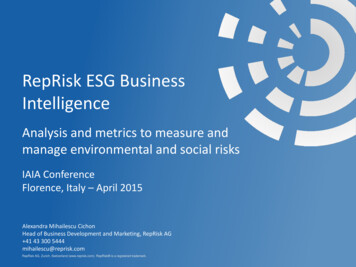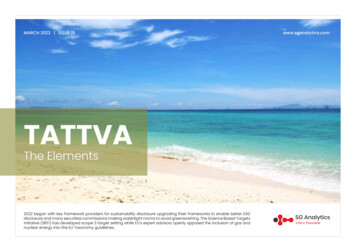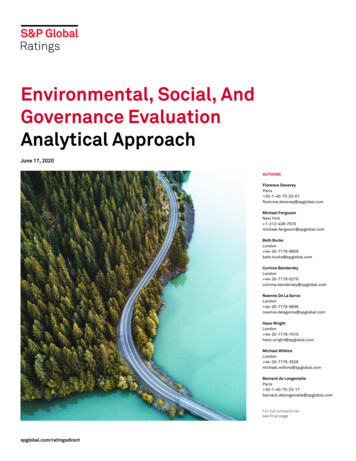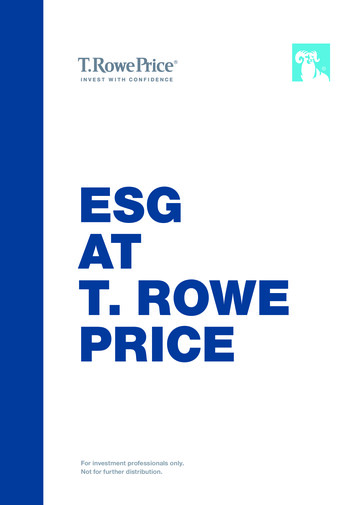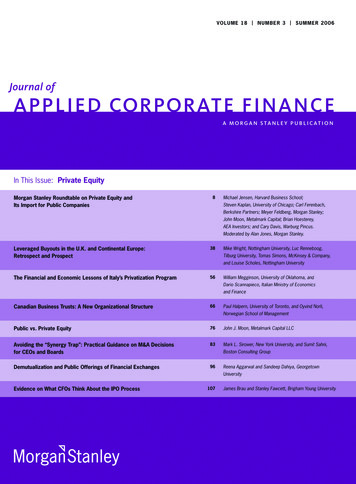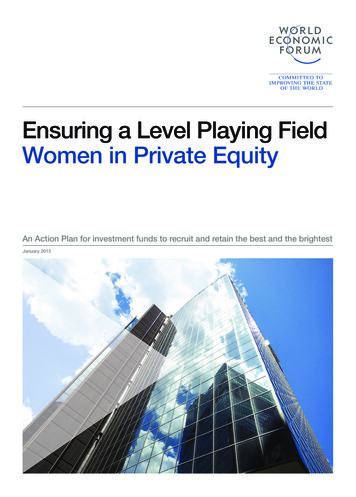
Transcription
ESG in Private Equity:A Fast-Evolving Standard
ESG in Private Equity: A Fast-Evolving StandardThis report was published by INSEAD’s Global PrivateEquity Initiative (GPEI). It was written by Bowen White,Research Associate at the GPEI, under the supervisionof Claudia Zeisberger, Academic Director of the hip and Family Enterprises at INSEAD,and Michael Prahl, Executive Director of the GPEI.We would like to thank the GPs participating in ourreport for their availability, candor and engagement.We would also like to thank Hazel Hamelin, senioreditor at INSEAD, for her invaluable support.The GPEI looks to partner with stakeholders in theprivate equity industry to collaborate on researchideas and projects. Its core supporters are:GPEI welcomes private equity investors interested inthe center’s research efforts to reach out to us inEurope or Singapore. For further information onINSEAD’s Global Private Equity Initiative, please visitwww.insead.edu/gpei.1
ESG in Private Equity: A Fast-Evolving StandardContentsOverview and Findings3General Partner Snapshots9 The Abraaj GroupACTISApax PartnersBC PartnersThe Carlyle GroupDoughty HansonKKRPartners GroupPermiraStandard Chartered BankTerra Firma Capital PartnersSummary Comments42Appendix A43Further Reading44May 20142
ESG in Private Equity: A Fast-Evolving StandardOverviewThe ability of private equity firms to manage environmental, social and governance (ESG) investmentconsiderations in their portfolio companies has received increased attention of late. Private equity firmson the fundraising trail are not the only GPs1 cognizant of this trend; cost-savings potential, competitoractivity and regulation all contribute to the rising awareness of ESG factors in investment committeedecision-making.2 The focus on ESG considerations has developed alongside investors’ growingappreciation of the impact that nonfinancial factors can have on value creation, long-term companyperformance, and the health of society at large.Over the past half-decade, this rising level of awareness has been spurred on by several organizationsand industry bodies that have developed guidelines on best practice. The United Nations-supportedPrinciples of Responsible Investment (UNPRI), drafted by an international network of investors, providesa framework for incorporating sustainability and ESG management best practices into investmentdecisions and ownership practices across asset classes.3 In coordination with the UNPRI, the PrivateEquity Growth Capital Council (PEGCC) developed Guidelines for Responsible Investment focusing onenvironmental, health, safety, labor, governance and social considerations specifically in the context ofprivate equity investment.4 The UNPRI and PEGCC guidelines combined with internal responsibleinvestment policies often provide the foundation for a GP’s ESG framework.After conversations with LPs and GPs on the subject, the time was right to share a collection of casestudies and offer a bird’s-eye view of the processes employed by a selection of leading private equityGPs. Detailed 3-page “snapshots” showcase the frameworks each has developed to address ESG acrosstheir organizations. These were compiled directly from interviews and conversations with theprofessionals responsible for ESG at each firm. While presented in a consistent framework, they arelargely verbatim accounts.As our first publication related to ESG, this report establishes a base for our ongoing work on ESG in theprivate equity industry. We trust that it will provide a practical guide and food for thought for privateequity professionals – both GPs and LPs – looking to develop a robust understanding of the currentapproaches to managing ESG investment considerations in portfolio firms. This paper is published withthe express desire to engage more GPs in discussions as they develop their capabilities related to ESG.We look forward to continued engagement with and input from the industry.1A general partner (GP) is the investment advisor that raises and manages a specific PE fund.“ESG in Private Equity – 2013: Perspective and best practices for managing environmental, social and governanceissues” – Malk Sustainability Partners, June 2013.3For further information, visit www.unpri.org.4For further information, visit www.pegcc.org.23
ESG in Private Equity: A Fast-Evolving StandardApproach and FindingsIn 2005, the United Nations Environment Programme Finance Initiative published the FreshfieldsReport5, which linked managing ESG factors to investors’ fiduciary duty, thereby thrusting ESG into themainstream investment industry. Prior to that report, GPs had focused primarily on managing headlineand reputational risk by ensuring that portfolio companies remained compliant with local legal andregulatory requirements. By mitigating this risk during the holding period, GPs could remove potentialimpediments to realizing the full value of a company’s operations on exit.INSEAD’s Global Private Equity Initiative (GPEI) set out to highlight the evolving frameworks employedby private equity GPs for managing ESG investment considerations. To gain a more granularunderstanding of where the industry stands on these matters, we conducted a series of interviews with11 prominent buyout and growth equity firms. We found that while certain themes underpinned all ofour conversations, no two frameworks were completely alike. As such, we saw value in sharing adetailed account of each GP’s approach with a wider audience, as well as inviting reactions andfeedback.The GP SnapshotOur research started with conversations with 11 firms, all of whom had policies and procedures tomanage ESG investment considerations. We summarized hours of interviews with each participating GPand condensed our findings into 3-page snapshots consisting of:SummaryGraphicCaseStudyA written description of the GP’s approach to managing ESG considerationsAn illustration highlighting a central tenet of each GP’s approach to ESGA case study detailing the GP’s approach in actionTo make the 11 descriptions as objective and comparable as possible, we created a framework ofheadings highlighting the Background, Policy Development & Execution, Pre & Post-investmentprocesses, Measurement & Valuation, and Lessons Learned related to each firm’s ESG framework.We begin by sharing several observations from our research, including the emerging ESG frameworksemployed by the industry, the challenge of measuring and valuing ESG activity, and the role of ESG inemerging markets.5“A Legal Framework for the Integration of Environmental, Social and Governance Issues Into InstitutionalInvestment” – Prepared by Freshfields Bruckhaus Deringer for the Asset Management Working Group of theUnited Nations Environment Programme Finance Initiative, October 2005.4
ESG in Private Equity: A Fast-Evolving StandardI.Emerging FrameworksAlthough managing environmental, social and governance factors in isolation is not a new concept inprivate equity investment, developing and applying a broad framework to manage ESG investmentconsiderations very much is. Given the relatively early stage of development, the industry is still insearch of definitive best practice. However, by examining the experiences of our research participants asa whole, we have identified three emerging frameworks currently employed for managing ESGconsiderations. These are not necessarily mutually exclusive, and a single GP may fall into more thanone category. As global ESG themes and the ability to manage them continue to evolve, we expect theapproaches taken and the frameworks applied to converge towards best practice.Risk FocusESG risk factors are assessed mainly during the pre-investment process. Arisk assessment primarily evaluates a target company’s compliance withlocal laws and regulations with a view to mitigating reputational risk. Ahigh ESG risk assessment often precludes investment. Proactive riskmitigation often entails only a minimum level of compliance.ProgramDrivenGPs actively manage ESG investment considerations through targetedinitiatives. Steps taken are often tangible, tailored programs focused on aspecific company, an industry sector, or the portfolio as a whole. Firmsimplementing this framework typically hire an experienced ESG specialistto understand portfolio companies’ needs, identify investmentopportunities, execute initiatives, and validate performance.IntegratedApproachA broad framework defines ESG activity across all relevant GP functionsincluding investment, portfolio operations, investor relations, and legal.Policies and procedures are typically integrated into existing systems andreviewed by ESG governing bodies. Such frameworks provide investmentprofessionals and ESG-dedicated staff with a broad outline to managingESG investment considerations over the life of a fund.As GPs begin to develop a framework for managing ESG investment considerations, they must makespecific decisions related to its structure, capabilities, and resources. Despite the diverse range ofinvestment activity of our project participants, we found several common drivers for establishing aneffective ESG framework, including securing a commitment to ESG from senior leadership and focusingon value creation (see Appendix A). The key drivers identified by our participating GPs are included ineach three-page snapshot, while the 11 case studies provide additional insight into developing aneffective approach to managing ESG considerations.5
ESG in Private Equity: A Fast-Evolving StandardII.Where Does Your Firm Stand? Esg – eSg – esG – TopographyThe ESG considerations material to investment decision-making vary from GP to GP. For some,environmental factors are at the fore; for others, social or governance issues may represent the ESGthemes key to decision-making. Ultimately, they will be largely driven by a fund’s individual investmentsand a firm’s investment mandate as the relevance of ESG factors differ from one geography to another,and one industry to another. The following section provides insight into the three categories of ESG,highlighting the approach and initiatives that participating GPs employ.GPs predominantly focus on value creation by improving eco-efficiencyand developing environmentally sustainable products and services. USGPs are recognized leaders in driving eco-efficiency; KKR’s Green PortfolioProgram and Carlyle’s EcoValuScreen are two initiatives that help portfoliocompanies identify opportunities to reduce costs and their environmentalfootprint. Terra Firma’s 2007 spin-out of Infinis from Waste RecyclingGroup – which created what would become the largest independentrenewable energy generator in the UK – underscores the opportunity tocreate value when focusing on environmentally sustainable services inportfolio investment.ESGEGSSEGGPs manage developmental impact, labor, and health and safety factorsaffecting portfolio company stakeholders. Managing social considerationsand impact in a portfolio company’s community is particularly relevant inemerging markets. Actis’ work with Umeme – a Ugandan powerdistribution company managing 99% Uganda’s electricity grid – highlightsthis point: infrastructure modernization led to a 94% drop in fatalitiesfrom fallen wires and other failures over a 5-year span. Similarly, Abraaj’sinvestment in Regimanuel Gray Limited provided leverage capacity for thecompany to continue to deliver affordable housing to low and middleincome families in Ghana and West Africa.GPs ensure that portfolio companies have a robust governance structurewhich enables effective business review and control. Effective governancehas long been an integral facet of private equity ownership; additionalfocus is paid to anti-bribery, anti-corruption, and environmental & socialperformance reviews in the context of ESG. In its investment in Netafim,Permira collaborated with the company’s founding Kibbutz organization tocreate a strong, independent board. For the Standard Chartered BankEnergy, Resources & Infrastructure team’s investment in Navigat GroupPte. Ltd., a formal protocol for reporting environmental and social mattersto management and the board was established.6
ESG in Private Equity: A Fast-Evolving StandardIII.ESG Measurement & ValuationIdentifying a comprehensive way to measure the specific impact of a company’s operations and ESGrelated initiatives emerged as the key challenge facing the private equity industry today. Solid data andtargeted analytics can be a critical driver for motivating and directing a company’s efforts. Working withportfolio company management to identify the right metrics relevant to the business can helpemployees focus on KPIs that drive value and avoid wasted administrative effort. In all cases, routinelytracking performance improvement over time is a critical step and a clear differentiator in terms ofsustained performance improvement. For example, to facilitate and streamline data capture, Apax hasinstalled Credit360, a software solution used by multinational corporations, across its portfolio. Thesoftware allows portfolio companies to tailor their KPI set to their industry subsector and to tracksustainability related performance over time.Developing a model that directly links a company’s active ESG management to monetary value is acrucial step for the future development and integration of ESG management capabilities across theprivate equity industry. Currently, environmental improvements are the most commonly valued, rangingfrom improved eco-efficiency to green products. Indirect value such as that created from improvedreputational risk management, improved governance, or better labor standards is recognized buttypically not explicitly measured. However, the impact of less-quantifiable improvements related to ESGhas been identified as a lever to increase exit valuations, or at a minimum to reduce a company’s cost ofcapital. For example, the ability of Navigat Group Pte. Ltd. – a portfolio investment of StandardChartered Bank’s Energy, Resources & Infrastructure team – to raise capital from international financialinstitutions with stringent standards related to ESG performance, highlights this point nicely.One model that addresses the challenge of valuation is the Total Impact Measurement andManagement (TIMM) framework developed by PricewaterhouseCoopers. PwC works closely withprivate equity firms on ESG management and has advised industry bodies on ESG measurement andvaluation techniques. The framework guides decision-making by assessing a company’s social, fiscal,environmental and economic impacts. TIMM applies monetary value to corporate environmentalimpacts by valuing the changes in human welfare associated with changes driven by corporate emissionsor resource use. The framework values social impact by assessing how a company’s activity affects socialwelfare and applying non-market valuation techniques to assign monetary value.7
ESG in Private Equity: A Fast-Evolving StandardIV.ESG in Emerging MarketsESG considerations play a special role in emerging markets as investments have the ability to impactlocal communities on a larger scale than in developed economies. While the focus in developed marketsis often on environmental and governance factors, GPs active in emerging markets have a distinctopportunity to deliver impact by managing social factors in their investments. Reflecting this difference,they draw heavily on a wider array of sustainability and governance frameworks developed specificallyfor investment in emerging economies, notably the IFC Performance Standards on Environmental andSocial Sustainability.Private equity investors can generate social impact in emerging markets due to the scarcity of financialresources and industry best practice in these economies relative to developed markets. Targetedinvestment and improved management and operational techniques lead to lower prices for goods andservices, reducing the injustice of the poorest paying the highest prices for everyday necessities. Theyoften lead to better, safer products than hitherto available in the local market. For example, Carlyle’sinvestment in Yashili during 2009 and 2010 and its subsequent improvements in raw milk powdersourcing and quality control differentiated the company from local competitors and provided a safe,high-quality product to Chinese consumers.Increased portfolio company commercial activity typically also improves standards of living foremployees and their families, through higher wages as well as investment by the company in betteraccess to training, healthcare and schooling. Communities also stand to benefit from higher tax returnsand improved infrastructure.Several project participants active in emerging markets highlighted the importance of addressing healthand safety considerations at portfolio companies and in supply chains in these markets. FollowingPermira’s investment in Hugo Boss in 2007, the company established mandatory social and laborstandards for its facilities and suppliers, validated by a global audit of its entire supply chain. By focusingon health and safety factors affecting not just employees but the community at large, Umeme, anelectricity distribution Actis portfolio company, sharply reduced the number of fatal accidents fromelectrocution thanks to investment in distribution infrastructure and improved accident responsetiming.Environmental considerations are no less important in emerging market investment. Implementingstandardized operational best practice can have a major impact on resource efficiency, driving downwaste and improving energy efficiency. Incorporating best practices in agriculture and fisheries canresult in increased yields and improved sustainability.As in developed markets, private equity firms active in emerging markets tend to focus on governanceas the core of their business model. Yet better governance serves a purpose beyond the specificcompany by signaling that firms which embrace transparency and checks and balances can succeed. Thefocus is often on training existing management and expanding a management team’s expertise throughexternal hires, and on enhancing the transparency of boards by appointing external and trulyindependent directors. Measuring and sharing financial and non-financial KPIs provides additionalgovernance levers to drive improved business performance and control in emerging markets.8
ESG in Private Equity: A Fast-Evolving StandardThe Abraaj GroupBackground: Managing ESG considerations has been a key tenet of The Abraaj Group since itsfounding in 2002. The firm’s initial approach to ESG focused on mitigating risks and drew heavily onmany of its employees’ experience working at the CDC Group. In 2006, Abraaj incorporated the IFCPerformance Standards into its policy as guiding principles for managing social and environmentalsustainability. Two years later, Abraaj launched a comprehensive overhaul of its approach to ESG andimplemented procedures to more formally manage both ESG risks and opportunities throughout theinvestment process. The same year, the firm launched the Abraaj Sustainability Index, a comprehensivesystem to measure a partner company’s development impact from a private sector perspective. A 2009signatory to the UNPRI, Abraaj’s current policy related to environmental and social factors draws on the2012 IFC Performance Standards, and its governance policies draw on a stakeholder model defined inthe King Code of Governance for South Africa.Policy Development & Execution: Managing ESG considerations falls within the mandate ofthe Abraaj Performance Acceleration Group (APAG), a team whose primary role is to providecommercial, operational, strategic and ESG support to Abraaj’s investments. The firm’s ESG policy isreferenced in its limited partnership agreements, explicitly linking ESG considerations to its fiduciaryduty. Oversight of the firm’s ESG policy is managed by its Management Executive Committee and theAbraaj Sustainability Council. Convened in 2013, the Sustainability Council meets at least twice a yearand brings together thought leaders to provide guidance on how the Group can further increase insustainability impact and to review and sign-off on the firm’s ESG policy. Executing the firm’s ESG policyfalls to Abraaj deal teams, partner company management, and partner company board members atdifferent stages of the investment process, with ongoing support from the APAG team.Pre-Investment: Several processes guide deal teams through the assessment of ESG factors duringthe Abraaj pre-investment process. Deal teams first screen a potential investment by sector andindustry, ensuring the target does not fall on Fund or general exclusion lists and assigning the target aninherent risk rating based on its Global Industry Classification Standard (GICS). Deal teams then employ aten-point risk model to determine company-specific managed risk ratings for environmental, social, andhealth and safety factors. In addition, a target’s governance processes are assessed via a governance riskmatrix developed by the APAG team. The matrix also provides specific steps a target can take toimprove its governance capability. The two risk ratings define a company’s overall risk profile and guidedeal teams when determining ESG due diligence requirements for a potential investment. In the eventof a high risk assessment, external due diligence providers must be engaged, while the need for externaldue diligence for medium-risk targets is decided on an investment-by-investment basis. Following duediligence, deal teams prepare corrective action plans to address ESG risks and value creation plans tocapitalize on ESG opportunities at the target company. Some corrective action plans contain conditionsprecedent to close which must be executed before Abraaj’s investment can move forward.Post-Investment: Following acquisition, partner company management is responsible forimplementing any remaining corrective action and value creation plans. Partner company managementteams have access to Abraaj’s deal teams and regional and global APAG members from whom they candraw support. A residual risk assessment of environmental, social, health and safety, and governancefactors is carried out following investment to assess the impact of implemented action plans and to9
ESG in Private Equity: A Fast-Evolving Standardclearly define remaining ESG risks. In addition, the APAG team works proactively within the portfolio toidentify ESG priorities and opportunities. Partner company ESG performance is reviewed by deal teamson a quarterly basis through the Portfolio Review Committees, and an in-depth annual review andreport on ESG considerations in all investments is prepared for Fund investors.Measurement & Valuation: The Abraaj Sustainability Index (ASI), a proprietary tool launched in2008 and in the process of being updated, measures the sustainable development impact of Abraaj’sinvestments. The Index aggregates 70 quantitative and qualitative indicators related to themes offinancial performance, environmental impact, human development and private sector development toproduce a single company score. This score allows Abraaj to assess the evolution of partner companyESG performance over time and compare it to other constituents of its investment portfolio. The Indexenables Abraaj to engage with partner companies beyond the financials and identify how partnercompany management and Abraaj’s resources can be utilized to create sustainable development impactby focusing on the intangibles.Lessons Learned: Abraaj identified two aspects of its ESG approach that help with theimplementation of an effective framework: Execution of ESG management must be completely merged into the overall responsibility of dealteams. Abraaj initially managed ESG considerations via a dedicated team, but found given thedepth and breadth of its portfolio, an integrated approach was needed. The ESG function wasconsequently integrated within the APAG team. ESG tools and processes must be consistently updated to ensure their relevance with emergingtrends and best practice, and to provide efficient, functional solutions to deal teams.Graphic 1: The Abraaj Sustainability Index provides a tool to measure the sustainable developmentimpact of Abraaj’s investments.10
ESG in Private Equity: A Fast-Evolving StandardAbraaj Case Study:The name Regimanuel Gray Limited (RGL) is synonymous with home construction in Ghana. Throughacquisitions and organic growth, RGL has built a holding company that operates across the constructionvalue chain, providing a diverse range of products and services both in Ghana and to the rapidly growingWest African real estate sector. While the company has developed commercial property, RGL’s targetmarket remains low to middle-income homeowners.In 2008 and 2009, The Abraaj Group invested in RGL, a company with which the deal team had a fouryear working relationship as a partner company under a previous fund. Since Abraaj’s 2008 investment,RGL has delivered more than 260 units and is currently constructing approximately 400 residential unitsmade up of both houses and apartments. The company has a multidimensional development impact onWest African communities, as the following examples portray.Economic Linkages: RGL has been the leading supplier to an underserved housing market for almost twodecades. Its expandable starter houses have been extremely successful, allowing potential homeownersto purchase two-bedroom units and add to them at their own pace. Since Abraaj’s investment, RGL haspaid US 10.7 million in taxes and spent more than US 54.1 million on local services and utilities.Health, Safety & Environment: RGL strives to limit its impact on the environment before, during andafter construction. In accordance with sector regulations, RGL prepares full Environmental ImpactAssessments for all of its planned developments. In the design of its developments, RGL plans for watersprinkling and, where feasible, tarmacking roads to contain dust pollution from impacting surroundingenvironments. It also provides storm water drainage and sewage systems and ensures that constructionand operational waste are recycled or disposed of properly.Socio-Economic Impact: RGL is mindful of both internal and external stakeholders. Employee packagesfor its 608-strong staff include above-market wages, medical benefits, as well company contributionsinto a staff provident fund. The company also spent more than US 10,000 in staff training costs in 2013.Private Sector Development: RGL’s role as a market leader in the supply of residential real estate is vitalin addressing the severe housing deficit in West Africa. Among several developments currently underway, the company’s experience in developing turnkey projects has led to a joint venture with thenational pension fund to develop 2,000 units of low-to middle-income housing in the port city of Tema.Management and Governance: Since its initial investment in 2004, Abraaj has been able to significantlyimprove the company’s corporate governance structures, transforming RGL from a typical familymanaged business to the institutionalized professional firm it is now. The company now has subcommittees to the board with appropriate charters, and Abraaj is represented on all such committees.The RGL investment provided a compelling opportunity for The Abraaj Group to partake in the highgrowth of West African Real Estate-related sectors. The Group’s investment provided much neededleverage capacity for the company to be able to continue to address this infrastructure gap in Ghana andthe sub-region.11
ESG in Private Equity: A Fast-Evolving StandardACTISBackground: Actis’ commitment to managing ESG considerations derives from its belief that itsinvestments bring benefit to investee companies, investors and broader society. The firm’s approach isrooted in its history and draws in part from its founding as part of the CDC Group plc, from which itdemerged in 2004. Actis’ original ESG policy focused on risk mitigation, drawing upon nationalregulations in portfolio companies’ home markets and IFC project finance performance standards andunderlying guidelines. This narrow focus expanded over the years to include value creation initiativesfocusing on both ESG risks and opportunities. Actis assesses ESG factors across five categories:environmental, climate change, health and safety, business integrity, and social. The firm is a 2009signatory to the UNPRI and a member of its Private Equity Steering Committee.Policy Development & Execution: Responsibility for managing ESG risks and opportunities inpre and post-investment periods lies with Actis investment managers and portfolio companymanagement respectively. Top-down definition of the Actis ESG policy is governed by the firm’sResponsible Investment Committee, which meets twice a year to examine ESG considerations across theportfolio and to set broad guidelines for the firm. Actis has had two director-level professionals solelydedicated to looking after the firm’s ESG activity since its demerger from CDC. Their role is to helpcolleagues understand how to approach and manage ESG risks and opportunities in the context of Actispolicies and procedures. The ESG team participates in all review stages of the investment processincluding deal screening, Investment Committee reviews, and exit reviews. The ESG team also providestactical assistance to portfolio companies by mentoring managers, recruiting ESG professionals, andinstalling appropriate ESG review processes.Pre-Investment: Investment managers are encouraged to actively communicate with the Actis ESGteam to assess material ESG factors during deal origination. Screening at this stage ensures thatportfolio company activity does not fall on Actis’ prohibited investment lists, and that Actis and targetcompa
the center's research efforts to reach out to us in Europe or Singapore. . studies and offer a bird's-eye view of the processes employed by a selection of leading private equity . which linked managing ESG factors to investors' fiduciary duty, thereby thrusting ESG into the mainstream investment industry. Prior to that report, GPs had .
